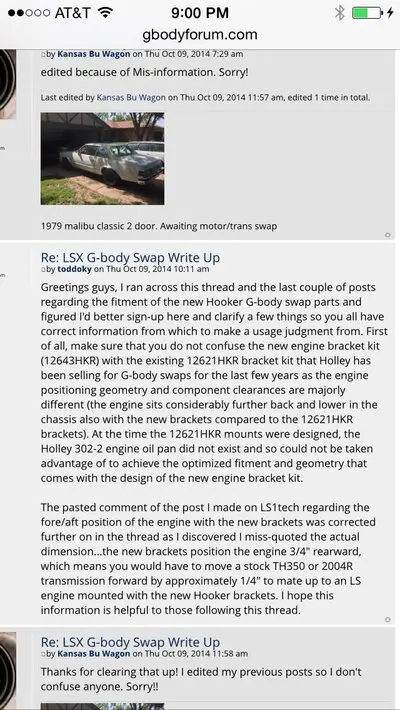In reading the exchange of information regarding the new Hooker components here it seems that some key points regarding their geometry has not been mentioned/discussed, which makes it hard for someone contemplating an LS swap in a G-body to gauge their value in regards to be able to help achieve specific swap goals a G-body swapper might have.
It's absolutely true that many G-bodies have been LS swapped to date using inexpensive (we'll just say $45-$100 for the sake of comparison) 1" set-back plates. This is typically done in order to be able to leave the stock TH350 or 2004R transmission in place to minimize the overall cost of the swap. That's all fine and good, but the use of this method of swapping an LS into a G-body brings certain geometric characteristics with it that would be negative in the minds of those wanting to end up with a vehicle that is optimized for handling and performance once the swap in complete.
What I referring to here is the higher engine height that results from stacking swap plates on top of the factory clamshell brackets; it increases the center of gravity of the car as well as the engine inclination angle and working U-joint angles of the completed vehicle. Neither one of these characteristics is beneficial towards building a car that is optimized for performance. The way around this obvious deficiency is to make engine brackets specific to this application that LOWER the engine height in the car in order to achieve optimized installed powertrain/driveline geometries. This is exactly what the new Hooker engine brackets do; only you can decide whether or not the additional $50 you'll have to invest for them is worth it to you to be able to hammer the throttle down post-swap with less worry of spitting your driveshaft out from under your car.
Aside from the better vehicle operational geometry that comes from the lower height of the Hooker brackets, there also the top-side packaging benefit that should be considered, which specifically means you can run the full truck accessory drive set-up without have to cut into the under-side brace in the hood and you also end up with more greater packaging space for turbos, intake plumbing, intake manifolds and air cleaner assemblies.
The Hooker brackets relocate the transmission bellhousing mating surface ever so slightly forward ( 1/4") of the stock position for a valid reason, which is to provide compatibility with the stock A/C evaporator case and provide sufficient space to install a 4L60 or 4L80 dipstick tube when those transmissions are used. If you are absolutely committed to keeping your transmission in the stock location to retain the use of your driveshaft, then the Hooker brackets would not be a good choice for you when installed in their as-designed location. You should be aware however that you can indeed use them in such an installation by merely slotting the holes in your frame rearwards by 1/4", just be aware that you will then have definite interference issues with the A/C evaporator case and the right side cylinder head.
This exact method of installation was used by Holley last year to configure two cars for the LS swap challenge at last year's LSFest event. 5.3L GM crate engines were installed by both teams into these cars while leaving the TH350 transmissions in place. The last point I would like to add is that it seems there should be more concern regarding the suitability of the stock driveshaft to hold up to the increased output that the LS swap delivers to it...up to a stock 5.3L truck engine I wouldn't worry so much, but using one for anything beyond that is a bit risky in my opinion if you plan on enjoying the increased power of the LS swap in an aggressive fashion. Holley installs 3.5" driveshafts in all its LS project cars to ensure against catastrophic failure of that component.
This post is not intended to say one way of swapping an LS into a G-body is better for you than another, but instead is intended to arm you with comprehensive level of information that allows you to make the best choice for yourself and your project.
I don't get to this forum very often, but it seems like there's a great passionate group of folks here that really enjoy their cars...I have to say I'm a much bigger G-body fan now than I was before I began development of the new Hooker G-body LS swap components. These cars can be made into something that is a blast to drive for sure.
Good luck to all you guys doing this swap and send me a PM if you need any further information.


